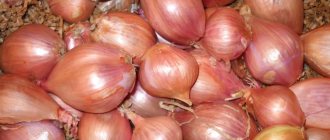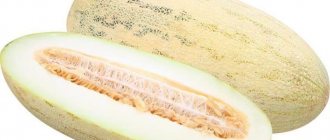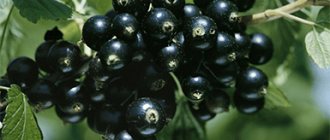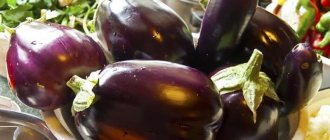Detailed characteristics and description
Appearance and photo
Radish fruits resemble watermelon, but not in taste, but in their appearance. The inside of the watermelon hybrid is just as pink, and sometimes deep purple. The fruits are round in shape and usually reach 8 centimeters in diameter. The skin of the radish is a delicate shade - somewhere between white and light green.
Reference! A distinctive taste feature of this fruit is that it is less juicy and even a little hard. The more ripe the fruit, the more pronounced its taste.
However, even a fully ripe vegetable will have a bitter taste closer to the middle of the fruit. But around the edges the radish is quite sweet.
Sowing time
The fruit ripens within a month. This property allows agronomists to grow several crops in one season. Watermelon radish is planted with seeds directly into open ground. This should be done only when the soil is warm enough. In different regions this period occurs at different times. However, this will not happen before the end of April to mid-May.
Productivity per 1 hectare
Watermelon radishes have high yields. Gardeners say that with proper care you can get several tens of tons from one hectare.
Where is it recommended to grow?
This root crop can be planted both in a greenhouse and in open ground. You can even sow it at home. The germination and growth rates of this type of radish are excellent. However, it is worth remembering that this vegetable loves short daylight hours. If there is enough light, the fruits will become bitter and hard. Therefore, you need to choose a more shaded place for growing.
Disease resistance
Breeders worked conscientiously to develop this hybrid. Therefore, watermelon radish turned out to be quite resistant to various diseases and pests. However, this does not mean that you can forget about preventive measures. It is still necessary to periodically feed the vegetable to increase its immunity.
Ripening period
We have already said that watermelon radish generally grows in 30 days. After this period, the fruits can already be dug up and eaten. It will not be possible to store radishes for a long time - a maximum of 2 months, and then at temperatures no higher than 6 degrees Celsius.
What types of soil does it prefer?
The most suitable soils are sandstones and clayey soils. Acidity should not exceed average (about 7).
If the soil is highly acidic, it is better to carry out a liming procedure before planting. It is important to ensure that the soil is well loose and saturated.
However, the soil should not be too full of organic matter.
In the fall, the soil must be dug up and fertilized with manure or chicken droppings.
Important! The optimal amount of manure is 4-5 kilograms per 1 square meter. It is also necessary to feed the soil with potassium and phosphate fertilizers in the autumn.
Before winter, the land plot is mulched. It is good to plant radishes in the area where cucumbers, potatoes or legumes previously grew. It is better not to plant root vegetables after carrots, cabbage and beets.
Description of varieties
Depending on the place of breeding, watermelon radish is divided into 3 varieties:
- European;
- Chinese;
- Japanese.
The fruits of the root crop have different shapes, tastes and colors. The vegetable can be round, flattened or oblong. The color of the pulp is white, yellow, red, pink or purple. Often when growing root crops, fruits with double color are encountered.
Advice! In our country it is recommended to grow a European or annual variety.
The fruit size is 7–8 cm. The peel is pale green and contains mustard oil, which is why the pulp closer to the peel has a bitter taste. The inside of the red radish variety is sweet and beautiful. The root vegetable acquires a pronounced taste and color as it ripens.
To have an idea of the beauty of red radish, you need to look at photos and videos.
What and where is it used for?
Not only the fruits, but also the foliage of radishes are suitable for consumption. Both the first and second are added to salads, okroshka and other cold soups.
This vegetable can be baked or served as a puree as a side dish. Culinary experts note that purees go well with cream.
- When stewed, the product is served with meat, poultry and fish. It is also added to vegetable stew. However, this cleans the peel.
- Now it has become fashionable to make cocktails from radishes, replacing them with lemon or other citrus fruits.
- Due to its external characteristics, watermelon radish is used as a decoration for dishes.
How to select and store black radish
The fruits are harvested in late autumn, almost before frost. The tops of the radish should be cut off and the root left. Before storing, check:
- degree of maturity of the root crop by lightly tapping, the sound should be dull;
- the presence of surface damage, when any wear leads to spoilage and mold on the radish;
- make sure there are no insect infestations.
Damaged radishes are thrown away, leaving only ripe, healthy root vegetables.
If in the fall after the rains the soil is loose and heavy, then digging up the vegetable is more difficult. You need to choose a dry, ventilated room or organize a canopy, spread out the radish harvest to dry. Dried soil is easier to knock down than wet soil.
Supplies should be checked periodically for spoilage and, if detected, such fruits should be removed immediately.
Closer to spring, the radish begins to sprout, greenery appears, which must be picked off. The vegetable spends all its energy on new growth of the stem and leaves. In this case, the root crop becomes looser, voids form inside, and it is more difficult to process.
If there is no space in the refrigerator, then a glazed balcony or loggia will do. The vegetables are placed in a bag with holes made for ventilation. You should periodically inspect and select spoiled fruits.
When choosing a radish at the market or in a store, first pay attention to the weight. A ripe, dense fruit should be heavy and elastic
The root shoot is difficult to tear off.
Freezing
In order to preserve all the properties of the product, the radish is frozen, the beneficial substances are not lost. It withstands low temperatures, which do not affect the nutritional value. To do this you need:
- wash root vegetables with a brush;
- remove the surface skin, roots and tops with a knife or vegetable peeler;
- put in containers.
- If the vegetable is used for salads, it is recommended to prepare semi-finished products:
- cut into thin slices, slices or cubes;
- chop with a grater or vegetable slicer.
Before storing in the freezer, the resulting juice is drained, and the prepared product is placed in bags. Radish has a specific smell. It is necessary to use a vacuum sealer, which will reliably protect other products from foreign impurities.
One option is to prepare salad mixes for appetizers from apples and carrots. Together with the radish, they are cut into strips and placed in containers. Before serving, defrost, season with lemon juice, a small amount of sugar and vinegar, and salt. None of the fruits loses either taste or nutritional value.
The same preparation is made for cosmetic and medicinal purposes. Lightly squeeze the juice from the radish after grating and place the workpiece in bags for freezing.
Juice from vegetables is prepared for future use. From 10 kg. it turns out about 3 liters. Store tightly sealed in a cool place.
Drying
None of the radish varieties can be dried due to their odor and excessively moist structure. Therefore, in order to preserve the harvest, it is better to use a cellar, refrigerator or freezer.
Canning, pickling
There are relatively few complex salad recipes for canning radish. Since the vegetable stores well, this is not required.
In the traditions of eastern peoples, especially among Koreans, there is a recipe for pickling that uses green radish and daikon.
Chemical composition
As for energy and nutritional properties, watermelon is in no way inferior to ordinary radish.
It contains the following micro- and macroelements:
- sodium;
- calcium;
- magnesium;
- fluorine;
- phosphorus;
- iron;
- B vitamins;
- vitamins A, C;
- nicotinic and salicylic acids;
- potassium.
The vegetable is also valued for its high dietary fiber content.
Reference! The unique composition of radish is considered due to its high content of carotene, enzymes, and essential amino acids. 100 grams of product contains only 20 calories.
The nuances of growing a plant
Soil preparation
To obtain a rich harvest of Watermelon radish, you should pay close attention to soil preparation.
- It is better to plant the crop in places where potatoes, tomatoes or cucumbers used to grow;
- the planting soil must be loose and nutritious, therefore, immediately before sowing, it is important to dig the bed to the depth of a bayonet shovel, and you need to add compost fertilizer and a complex of mineral fertilizers consisting of phosphorus and potassium;
- the acidity of the soil for planting radishes should be at pH 7;
- The soil must warm up well before planting.
Rules for selecting seeds for planting
The choice of high-quality seed is directly related to crop yield, so saving in this matter is not recommended. It is better to purchase seeds in specialized stores. When choosing them, it is recommended to give preference to large grains. In order for the germination of seed material to be more active, it is important to soak it in cold water for a day. This advice will also have a positive effect on the juiciness of the resulting fruit.
Planting process
A feature of Watermelon radish is its cold resistance, so it can be planted as early as April. Seeds are sown in pre-prepared holes 3-4 cm deep. They are sprinkled with a layer of earth on top. Next, you need to water the bed with warm water. You can also plant seeds in furrows rather than in holes; this will not change the quality of the fruit. The main thing is to leave a small distance between the seeds, otherwise the seedlings will turn out to be too thick and the fruits will be small. To speed up the germination process, you can cover the bed with polyethylene or a special covering material.
Useful and harmful properties
We have already written about how many vitamins, micro- and macroelements are found in watermelon radish.
- Such a rich composition improves the functioning of the entire body and improves immunity.
- Experts also recommend using it for people suffering from problems with the cardiovascular system.
- The root vegetable has a good effect on the functioning of the digestive system.
- The calorie content of radish is only 20 calories per 100 grams. Therefore, this product is included in the diet of those who want to lose weight.
Contraindications include stomach ulcers and high acidity. Since radishes strongly irritate the mucous membrane.
Benefits and harms
Gardeners know about the beneficial properties of the watermelon delicacy. It contains vitamins, acids, mustard oil, glycosides. Eating radish dishes restores strength in case of increased fatigue, normalizes the functioning of the gastrointestinal tract, and stimulates appetite. It has been noticed that after a long winter, introducing root vegetables into the diet restores immunity.
But people with diseases of the stomach, liver and kidneys should be careful when introducing watermelon vegetables into their diet: it can provoke an exacerbation of diseases.
Growing a variety: planting and care
Remember that the soil must already be warmed up before planting.
For each seed, a hole about 4 centimeters deep is prepared.
- Mineral fertilizer in granules is placed at the bottom, the whole thing is sprinkled with soil, and only the seeds are placed on top of this and also covered with a small amount of soil.
- Then all crops need to be watered with water at room temperature.
Shoots will appear in a few days.
Watermelon radish does not grow well in crowded conditions. Therefore, when planting, it is important to take this fact into account.
One of the main rules of care is timely hydration. You need to water regularly, but not too much. If hydration does not occur correctly, voids will form in the fruit. It is also necessary to observe the amount of light. If there is a lot of it, then the radishes will begin to produce unnecessary arrows.
In order for the vegetable to receive the required amount of light, you need to sow the seeds near trees or shrubs. If this is not possible, after the first shoots appear, you can cover them with black punctured film or a fine mesh. The most suitable growing temperature ranges from 20-25 degrees Celsius.
Twice a month, mineral fertilizers rich in potassium and phosphorus are applied to the soil.
Care: watering, fertilizing
Watermelon radish is an early ripening crop. It is recommended to apply fertilizers only once: when preparing the soil for planting.
The ridges should be watered as they dry out: once every 7–10 days. In case of heavy, prolonged precipitation, it is necessary to cover the plantings with film.
The alternation of drought and waterlogging of the soil is dangerous: the taste of root vegetables deteriorates, the pulp becomes fibrous.
Diseases and pests
High acidity levels can cause the development of viral clubroot. In this case, the fruits become unattractive in appearance, and also completely unsuitable for consumption. If you over-water the radish, fungal diseases may develop. To prevent this from happening, you need to keep the soil moisturized and loosen it as often as possible.
But the main dangers for radishes are the cruciferous flea beetle and the cabbage fly. These pests eat the leaf blades, which leads to drying of the fruit.
The main advantages and disadvantages of watermelon radish
Like any other agricultural crop, watermelon radish has a number of obvious advantages and some disadvantages.
| Advantages | Flaws |
| This variety shows constant high yield | Has a short shelf life |
| Has short fruit ripening times | Loses taste when grown for a long time |
| Rarely affected by diseases and pests | Loses appearance at room temperature |
| Suitable for transportation. |
Prevention of various problems
Attention! To protect the vegetable from attack by pests, you need to water the soil and spray the leaves with an infusion of water and wood ash. Ash can be replaced with tomato tops.
also good at repelling harmful insects. It can be added to the water several hours before watering so that the garlic can ripen. Moreover, not only the cloves themselves are used, but also the husks.
Fungicides from ready-made preparations help well. They are bred strictly following the instructions. The solutions should be used several times with a break of 5-7 days.
If you prefer more familiar varieties of root vegetables, then read about what they are and how to grow green, black, oilseed and Margenland radishes (Loba), as well as daikon.
Watermelon radish is a unique product whose popularity in Russia is only gaining momentum. However, those who grew the vegetable or prepared dishes from it already appreciated its taste, as well as its positive effect on the general condition of the body.
Red radish: properties
Calorie content: 20 kcal.
Energy value of the product Red radish: Proteins: 1.2 g. Fats: 0.1 g. Carbohydrates: 3.4 g.
Red radish is probably one of the most controversial representatives of this type of vegetable. Numerous disputes are caused by differences of opinion, for example, some scientists say that the red radish is a hybrid that arose from crossing radishes and radishes. Other experts believe that this is an ordinary radish that has simply grown to a large size. So far, scientists have not been able to reach a consensus.
Red radish has fairly large fruits, which weigh about 300 g. The root vegetables have a round or cylindrical shape. Behind the thin red skin is white dense pulp, which is also very juicy. In addition, at the moment hybrids have been bred in which, on the contrary, the peel is white and the flesh is red (see photo).
Red radish has a less pungent taste compared to, for example, the black version of this vegetable.
Harvest and storage
Since Watermelon radish can be harvested up to four times in one season, only the last one should be used for storage. Although the root crop is not afraid of lower temperatures, it must be collected before frost sets in. In dry weather, digging up radishes will be much more convenient and you will be able to immediately dry the fruits in the shade.
Damaged root crops are not suitable for storage, so the harvested crop must be carefully sorted. The tops need to be cut off, leaving 2 cm. Before putting the radishes in storage boxes, it is recommended to treat the root crops with ash or chalk. This will protect the crop from the development of rot and bacteria.
Traditional medicine - in favor of radish
Radish mixed with honey is a real “classic of the genre” in the fight against cough, known since childhood. However, few people know that this vegetable is recommended for nursing mothers who have problems with lactation. And compresses made from grated root vegetables are considered the most effective remedies against bruises and even rheumatism.
In addition, radish can temporarily relieve toothache: to do this, just rinse your mouth with freshly squeezed juice obtained from the vegetable. If you drink a glass of this miraculous drink every day, your metabolism will speed up and the person will begin to lose weight rapidly.
Features of growing in closed and open ground
In the regions of the middle zone, sowing begins in the third ten days of March in greenhouses or greenhouses. The first harvest is harvested in April.
Seeds are sown in unprotected soil in May and a harvest is obtained within a month. Subsequent planting is carried out in July and August.
When choosing a site for planting watermelon radishes, take into account the light level. An excess of sunlight is harmful: bolting occurs, flowers appear, which reduces the growth and formation of fruits. Therefore, sowing seeds is carried out near bushes and trees that create partial shade, or the plantings are covered with agrofibre.
Reviews
Cultivation of watermelon radish is practiced everywhere .
Farmers note the relative ease of care, high yield and pleasant taste. Ekaterina, Kirs : “I plant watermelon radishes for three years in a row in July, in the garden.
Caring for it is no different from ordinary bitter radish. The crop loves moisture, so I water it often, otherwise the fruits will grow too dry. In the spring I fertilize with humus and superphosphate.” Oksana, Gorodets : “I first saw such a radish at a friend’s house. I really liked the taste and color. The pulp is sweet, with a slight bitterness in the skin area. I wanted to try growing a crop in my dacha. I decided to sow in a greenhouse at the end of spring. The harvest was harvested in about a month. If you follow the rules of agricultural technology, there will be no problems with radishes. The main thing is to water regularly and remove weeds. Then the plant won’t get sick.”
Ilya, Tsimlyansk : “Last year I came across watermelon radish seeds. I decided to plant it at the dacha for the sake of experiment. Before this, I read the growing technology. It turns out there is nothing complicated about it. The culture grows like an ordinary black radish. I dug up the soil in the spring and fed it with manure. I planted the seeds at a distance of 50 cm. I watered them once a week and applied potassium-phosphorus fertilizer once. I sowed it in early July and harvested it in August.”
Cultivation care
Watermelon radish grows quickly and does not require much care. In order for the crop to develop well and form large root crops, it must be regularly watered and fed.
The soil is also loosened and weeded every 3-4 days. Loosening is necessary to prevent crust formation and improve soil breathability. Regular treatments allow the roots to receive oxygen - this accelerates the formation of root crops.
Watering
If you water the radish incorrectly and violate the moisture regime and norm, the root vegetables grow “empty”, not juicy, with a poorly expressed taste. When there is a lack of moisture, plants quickly shoot out shoots, and then the root crops turn out elongated, fibrous, and hard.
How to properly water watermelon radish:
- Clean water is used for irrigation. You can also add ash solution to the beds (this will be both fertilizing and watering). To prepare the solution, a glass of ash is diluted in a bucket of water.
- The radish is watered through a watering can with a rain nozzle.
- Watering frequency – 1 time per day. In summer, when the weather is hot, radishes are watered twice - in the morning and in the evening. If it rains, it is enough to water the beds 2 times a week.
- The crop is watered at least 5-6 hours before harvesting.
- Watering rate is 10-15 liters per 1 square. m area.
When overwatered, radishes are affected by fungal diseases.
After watering, the row spacing is mulched with organic or inorganic mulch.
Fertilizer application
Watermelon radish (radish) is an early-ripening crop, so it reacts poorly to excess mineral and organic fertilizers. The phosphorus-potassium mixture is applied only once - to the soil before sowing.
Radish grows very quickly, receiving from 1 sq. m area no more than 10 g of microelements. Therefore, there is no need to apply a lot of fertilizers during the growing season. The lion's share of fertilizers is applied before planting.
If there is too much nitrogen in the soil, the radish will begin to actively grow tops, and root crops will not form.
To feed radishes use the following:
- Nitrogen. Radish receives it with saltpeter (15 g per 1 sq. m) or urea (10 g per 1 sq. m). In spring, nitrogen is added to the soil no later than 2 weeks before sowing.
- Potassium. Use, for example, potassium sulfate (potassium sulfate) - 10 g per 1 sq. m when digging.
- Phosphorus. The most popular source is superphosphate. It is applied in the fall at the soil preparation stage (50 g of fertilizer per 1 sq. m). Ammophos can also become a source of nitrogen and phosphorus.











